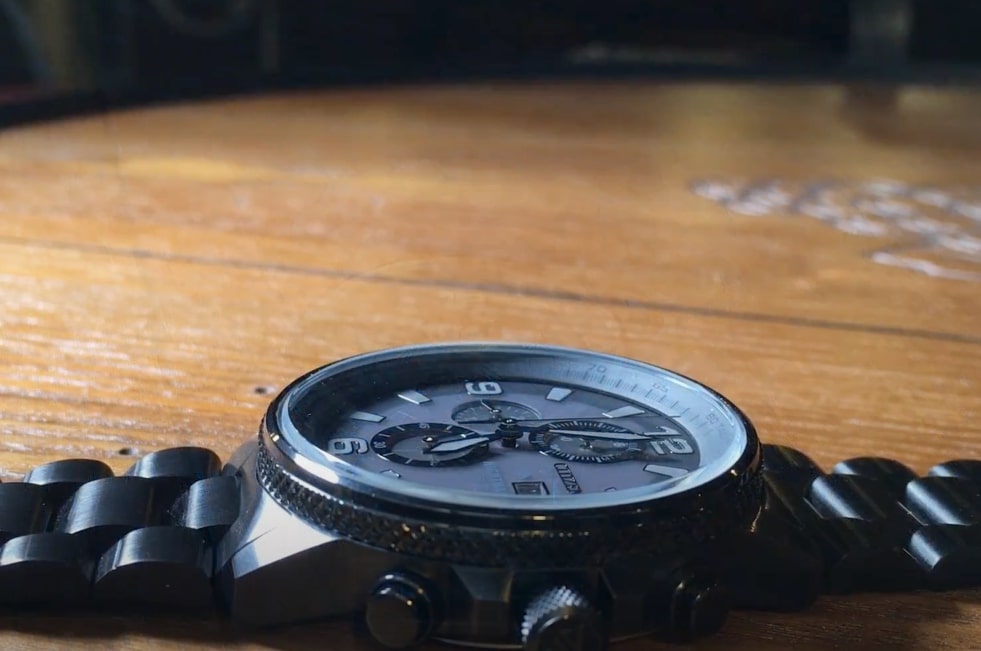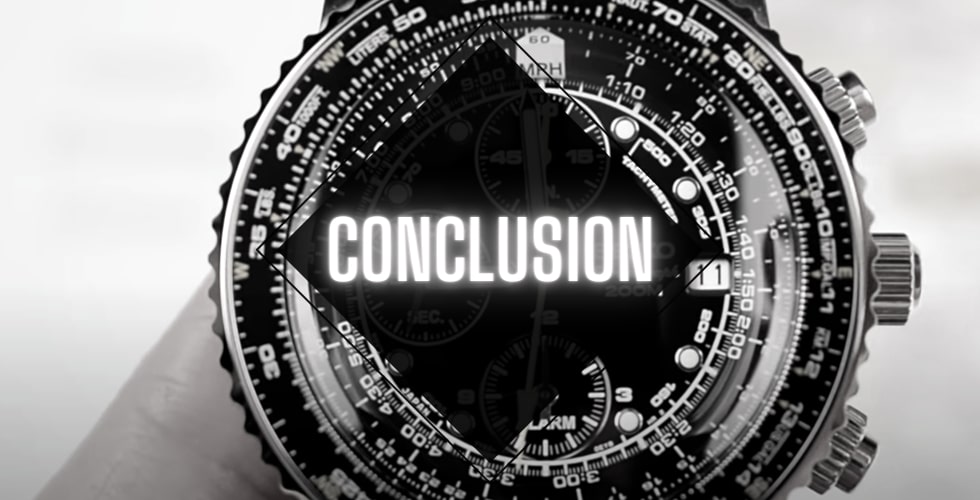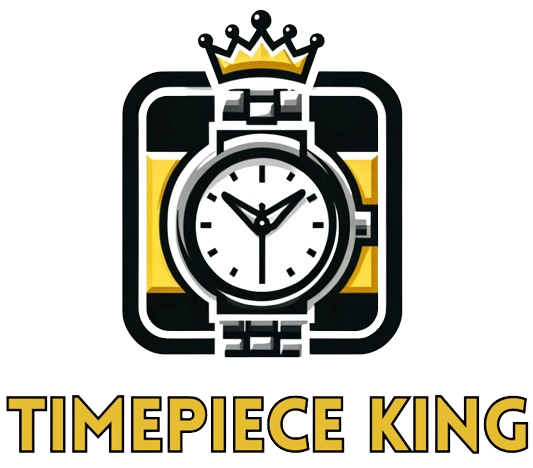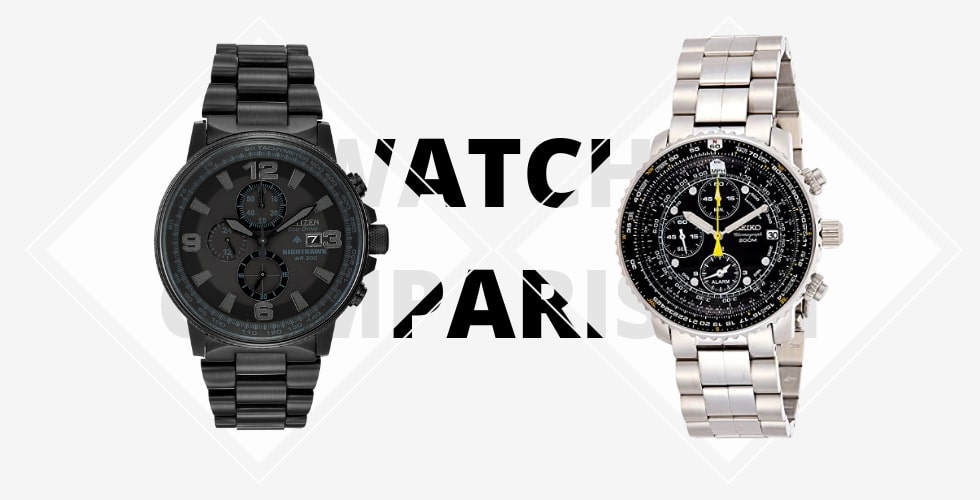If you’re a massive chronograph watch enthusiast just like I am, you will probably know how difficult it can be to find a capable timepiece in this category.
The list of watchmakers offering chronographs is pretty much endless nowadays. On one hand, it might sound like we’re spoilt for choice. On the other, there aren’t that many of those that can be trusted with delivering durable and accurate watches that will guarantee years of hassle-free use and stellar performance.
Being an avid watch enthusiast and now also a collector, I could say I’ve been to hell and back with some of the brands I had the “pleasure” of testing over the years. Some chronograph watches I’ve massively overpaid for, with others I thought I could get a well-crafted timepiece on the cheap.
All those experiences made me realize that in terms of chronograph timepieces, the best value is to be found with Japanese watchmakers. The holy trio of Casio, Citizen and Seiko rarely fails to deliver in terms of style, reliability, and affordable prices.
In today’s article, we will have a closer look at the two latter watchmakers, and particularly their two well-known collections of pilot chronographs (see also: Is Seiko Better Than Citizen?). After reading the Citizen Nighthawk vs Seiko Flightmaster comparison, you should have a better idea of which of the two excellent chronograph models is the best fit.
Timepieceking is reader-supported and might earn a commission (at no extra cost for you) for purchases made via links in this article.
Citizen Nighthawk vs Seiko Flightmaster (Overview)
| Product | Brand | Collection | Model | Price |
|---|---|---|---|---|
 | Citizen | Nighthawk | CA0295-58E | Check Price |
 | Seiko | Flightmaster | SNA411 | Check Price |
Seiko Flightmaster vs Citizen Nighthawk: Comparison
Although what’s inside the watch is equally if not more important than the exterior, it would be an obvious lie to say that we’re not drawn by the looks first. After all, you only get one chance to make a first impression, right?
Hence, we will start the comparison with the design of both timepieces.
For the purpose of today’s comparison, I’ve selected two of the best-selling models from each collection. When it comes to the Citizen Nighthawk line, we will review the CA0295-58E model. From the Flightmaster collection by Seiko, I’ve cherry-picked the SNA411 model.
Note: If you’re new to any of the brands, feel free to also read:
Without further ado, let’s go.
The Case
Both watch models come with durable stainless steel cases. The material is a common choice amongst all enduring watch models because of its strong scratch and stain-resistant capabilities. Design-wise, Seiko went for an all-time classic silver-tone. In contrast, Citizen opted for a darker, more adventurous style. Additionally, the Citizen Nighthawk model uses a black ion-plating on its case.
Size-wise, they’re nearly identical. They are equally thick, measuring 13mm in that aspect. There’s just a 1mm difference between the cases in terms of the diameter, with the Citizen Nighthawk model scoring 42mm and the Seiko Flightmaster 43mm.
But…
Whereas the Citizen Nighthawk model does feel like a 42mm watch when you wear it, the 43mm Flightmaster definitely wears smaller than the specs would suggest. The actual watch face measures just 32mm as the bezel and the slide rule eat up a large chunk of the visual space. When combined with a relatively short lug-to-lug length of 44mm, the model feels more like a 40mm watch than a 42mm watch. Heads up for folks with smaller wrists!
For maximum protection against water damage, both watches use solid, screw-down casebacks. The main crowns in both watches, as well as the two chronograph pushers, are also screw-down.
Because of the tachymeter scale, both timepieces are equipped with bi-directional bezels.
- 43mm ion-plated, stainless steel case
- Ion-plated 3-link stainless steel bracelet
- Mineral crystal dial window
- Japanese quartz movement
- Eco-drive technology - powered by light
- Water-resistant up to 200m
- 3 chronograph sub-dials
- Tachymeter
- Luminescent hands and markers
The Dial
Characteristically for chronograph watches, the dials in both models are jammed with features. But let’s focus on how they look first.
Beginning with the dial of the Citizen Nighthawk model, it matches the dark theme of the case. Going from the inside, it features a dark grey circle on which you will find all three chronograph sub-dials, as well as a date display window positioned at three o’clock.
Between two and three o’clock there’s a Citizen logo along with the Eco-Drive label. Betwixt 3 and 4 o’clock positioned is the mark of the Nighthawk collection with a water-resistance rating just below. Just outside the centrally-positioned grey circle located are 5-minute markings. Those include four Roman-numeral hours: 3, 6, 9, and 12. All the markers are luminescent.
Whereas the strong glow makes reading in the dark a piece of cake, the combination of dark-grey markers and hands and a dark background might make time-reading in certain environments an effort. If you share the same concern, you might want to check out the Blue Angel Nighthawk model.
Finally, on the outside part of the dial, you will find the tachymeter scale.
Moving on to the even more feature-rich dial of Seiko Flightmaster, it’s also predominantly black. However, instead of color-coordinating with the case and the bracelet, it boasts a nice contrast with the remaining watch parts.
The fact that it includes mostly white elements, probably makes the dial easier to read during the daytime. On the other hand, some critics, whose view I can also understand, think that Seiko overdid in terms of the dial design and how all these features are stacked against each other. True Seiko fans are still likely to appreciate the complex arrangement anyway.
Whereas Citizen Nighthawk dial is pretty level, Flightmaster’s comes with a combination of raised and reflective surfaces. Adding that to the slightly domed crystal and the cluster of sub-dials, the watch is definitely one that can grab and keep one’s attention. Having seen it in person, I can also say the model is a bit more “shiny” than the pictures and videos online would suggest. Such appearance makes it also a perfect fit for more formal occasions.
The inner circle of the dial should be classified as its main part. There you will find three oversized watch hands. They’ve been designed so on purpose to make the task of reading time on such a busily-arranged face easier. The hour and minute hands color-coordinate with the vast majority of dial elements whilst the arrow-shaped chronograph hand has been painted yellow. All three hands, as well as dotted minute/hour markers, are luminescent which makes time-telling in the dark a smooth sail.
The centrally-positioned circle also includes the most important part of any chronograph watch – the chronograph timers. On top of measuring hours, minutes and seconds, the sub-dial positioned at 6 o’clock comes with a Flight Alarm function. An additional perk of this sub-dial is that it can perform the task of a GMT watch – and that is to track time in a second timezone (see also: Top GMT Watches Under $1,000).
The main chronograph sweeps at a rate of 5-clicks/second, which gives it a smooth and faultless motion. Many fans of this Flightmaster marvel at how seamlessly the chronograph sub-dials reset. During the process, all the hands sweep around the dial in a very synchronized fashion.
Seiko Flightmaster comes with a sloped internal bezel which slightly improves the readability and further adds to its comment-worthy design.
Arguably the biggest stand-out feature of this excellent Seiko timepiece is the built-in rotary slide rule. Also called the “flight computer” by many Seiko aficionados, the watch’s bezel can perform a long list of mathematical operations, including:
- calculations – multiplication, division, square root, speed (based on distance and time), ETA (based on speed and distance), fuel consumption, climbing altitude, climbing rate
- unit conversions – distance (nautical miles, statute miles, kilometers, feet), fuel volume conversion (gallons, liters), weight conversion (pounds, kilograms), fuel volume-to-weight conversion
Performing all of those brings a lot of fun but at the same time takes a lot of practice.
- 42mm stainless steel case
- 4-link stainless steel bracelet
- Japanese quartz movement
- Hardlex crystal glass
- Water-resistant up to 200m
- Three chronograph sub-dials
- Tachymeter
- Rotary slide rule
- Luminescent hands and markers
The Glass
It’s hardly a secret that a dial is the most damage-prone part of any watch. Hence, it’s an absolute necessity that the timepiece comes with a durable glass that can withstand a lot.
Gladly, both the Citizen Nighthawk and Seiko Flightmaster use a reliable form of protection.
As far as the Citizen Nighthawk is concerned, the model uses a mineral crystal glass. On a durability scale, the material is somewhere in the middle. It’s a much more impact-resistant option than acrylic (plastic) but some way off the premium sapphire crystal glass. Considering the modest pricing of this model, it would be unfair to expect it to use the material. A decent Citizen model with sapphire glass is Citizen AT8020-54L.

When it comes to the Flightmaster model, it uses a Hardlex glass. It’s Seiko’s proprietary crystal type that is the most common pick in low-to-mid budget models. Despite being a catchy buzzword, it doesn’t really outshine the mineral glass in any way. Durability-wise, it’s equal to mineral crystal but weaker than the sapphire type.
The Bracelet
Both timepieces come with durable, yet classy-looking stainless steel bracelets. Both blend in gracefully with the cases made from the same material.
The Citizen Nighthawk uses a three-link bracelet with ion plating. Minimizing the risk of a slip and potential damage to the watch is a fold-over clasp with a double push-button safety closure.
Because of the more common and elegant silver-tone design, Seiko Flightmaster’s bracelet probably leans towards the dressy side of the spectrum. The bracelet is made of four links. The two center links are skillfully polished which harmonizes the case-bracelet connection. As far as the watch clasp is concerned, Flightmaster SNA411 uses an equally secure fold-over push-button clasp with a safety closure.
The Movement
The area in which there’s probably the most striking difference between these two excellent pilot watches is the movement. Although both are Japanese quartz (battery-powered) timepieces, the exact caliber couldn’t have been more contrasting.
Let’s begin with the movement of the Nighthawk model. The caliber installed in this watch is Citizen’s in-house B612. Unsurprisingly, it belongs to the family of the Eco-Drive movements. Eco-Drive is Citizen’s proprietary movement technology that allows the watch to run for decades without the need for battery replacement. How?
Ec0-Drive watches are powered by the light – “any light”, as Citizen markets these collections. Depending on the model, the power reserve of Eco-Drive watches differs. In the case of this Nighthawk timepiece, it’s 7 months. In practice, that means you could camp in the basement for that period of time and still expect your Nighthawk to show the correct time.
How about the accuracy? The caliber provides a quartz-standard accuracy of +/- 15 seconds monthly.

Akin to Citizen, Seiko is also a provider of their own movements. In fact, the brand’s calibers are used in watches of many other popular brands, such as Invicta (read also: Invicta Watches Review). Because of their long-lasting, accurate and affordable calibers, Seiko is considered one of, if not the most leading movement manufacturer in Asia.
The exact caliber used in the Seiko Flightmaster model is Seiko 7T62. The movement is a popular choice amongst Seiko’s mid-budget chronograph watches, such as Seiko Velatura. In contrast to the Nighthawk model, this movement needs a regular, replaceable battery to run (see also: How Long Do Watch Batteries Last?). You won’t escape a visit to a local watchmaker this time!
Unsurprisingly, the quartz movement provides a common accuracy of +/- 15 seconds/month, matching that of the solar-powered Nighthawk model.
Water Resistance
Both models are on the same page when it comes to their water use capabilities.
Even though the pair is considered chronograph pilot watches, they could put to shame some of the wannabe diving timepieces. With a water-resistance rating of 20ATM/200m, aided by the presence of screw-down casebacks and crowns, both timekeepers are safe companions for use in the water. That includes serious water sports and skin diving.
Warranty
Although both watches are highly unlikely to cause any troubles in the first few years of use, the fact that Citizen offers a considerably longer warranty period on all their watches might be a turning point for many considering the purchase of one of these watches.
Seiko’s 3-year guarantee period is pretty much a standard amongst most watchmakers – although it looks pretty bleak when compared with the 5-Year Warranty issued by Citizen.
Naturally, both brands are unanimous about the fact that, in order for the warranty to come into life, the issue with the watch can’t be caused by your own negligence, such as a cracked window or scratches on the case or bracelet.
Feel free to read more about: Seiko Warranty Policy and Citizen Warranty Policy.
Citizen Nighthawk or Seiko Flightmaster? Conclusion

I hope that the article has provided you with enough information to decide which of these two excellent pilot watches fits your needs better.
Summing up the Citizen Nighthawk vs Seiko Flightmaster comparison, it’s only fair to say that both watches provide excellent value for money. At the same time, each has its own unique qualities and style that you will have to consider before going ahead with the purchase.
That’s not to say they don’t share any similarities. An example of such is the quality of glass material. Even though they have different names (Nighthawk using mineral crystal and Seiko, Hardlex), they’re pretty much on the same page durability-wise.
Also, both are chronograph watches – and pretty good ones at that.
But how about the differences?
Starting from the exterior, Seiko Flightmaster will probably look better on you if you have a small-to-medium wrist. Even though there’s just a 1mm difference between the two models in terms of the case diameter, the Flightmaster model wears much smaller than the 42mm size would suggest. That’s down to the fact that the actual face of the watch measures just 32mm since the bezel and the slide rule take up much of the visual space.
In comparison, the Nighthawk model does indeed feel like a 43mm timepiece when you wear it. It’s probably best suited for folks with medium-to-large wrists.
Then we have the clearly visible contrast in terms of the movements. Despite the fact that both operate on Japanese quartz calibers with the exact same accuracy capabilities, the Flightmaster uses a standard battery-powered caliber whilst the Nighthawk model runs on Citizen’s proprietary Eco-Drive technology. Since the latter is powered by light and doesn’t require battery replacements, it will be a more appealing pick for eco-friendly and savvy folks.
Finally, you just have to say that the Flightmaster is a more feature-packed watch out of the two. The inclusion of the slide rule is something connoisseurs of the retro style will appreciate. At the same time, many will find the arrangement of the dial too chaotic and thus, difficult to read. Whether you see the feature-rich watch face of the Flightmaster as an advantage over the more modest arrangement of the Nighthawk will depend on your own needs and style.
Considering the affordable pricing of both these watches, their reliability and the long list of features they come with, you are unlikely to be disappointed with either of the two. The final choice will depend on what specific watch features you’re looking for.
If today’s article has helped you made your mind up, I’m glad. I would love to hear about your pick in the comment section below.
Also, if you’re interested in more watch collections from these two excellent Japanese watchmakers, check out my other articles: Best Seiko Diver, Best Citizen Dive Watches or Citizen PCAT Review.


I like the comparison between Citizen and Seiko.
BUT the better comparison would be The Seiko Flightmaster SNA411 versus the Citizen eco drive Blue Angel AT8020-54L (has the slide rule also). Where citizen has eco drive and sapphire glass, Seiko has the tachometer and alarm clock. Both worthy adversaries and I would buy both to prevent that watch anxiety of not having bought the other,,, The Blue angel can be bought with a faux leather Blue and Yellow band (not really inter changeabe with the bracelet version as lug holes might be different spaced.)